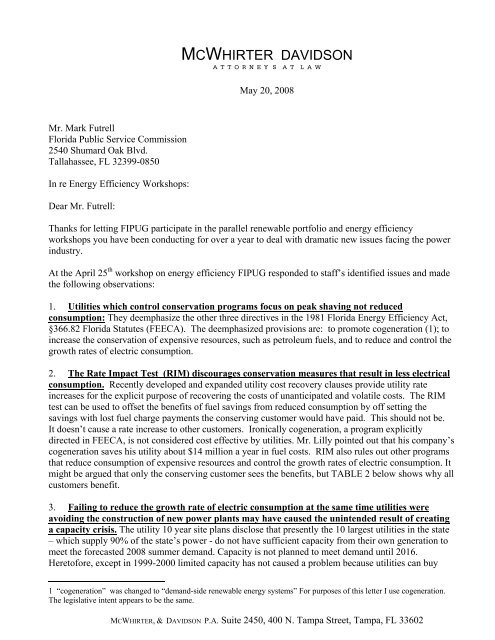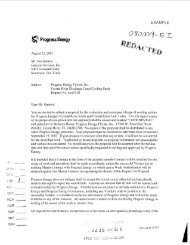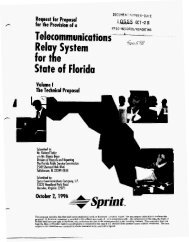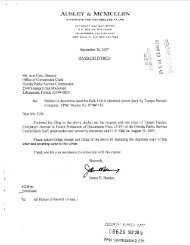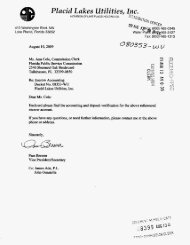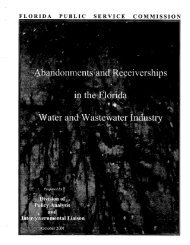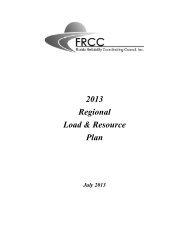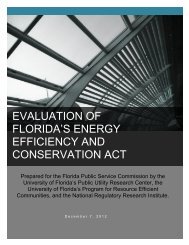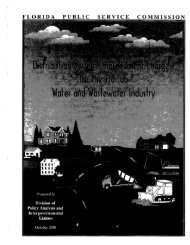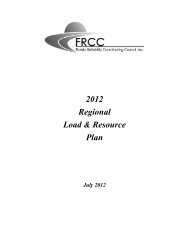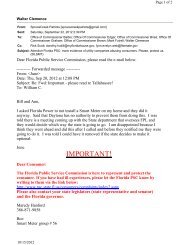fipug - Public Service Commission
fipug - Public Service Commission
fipug - Public Service Commission
Create successful ePaper yourself
Turn your PDF publications into a flip-book with our unique Google optimized e-Paper software.
MCWHIRTER DAVIDSON<br />
A T T O R N E Y S A T L A W<br />
May 20, 2008<br />
Mr. Mark Futrell<br />
Florida <strong>Public</strong> <strong>Service</strong> <strong>Commission</strong><br />
2540 Shumard Oak Blvd.<br />
Tallahassee, FL 32399-0850<br />
In re Energy Efficiency Workshops:<br />
Dear Mr. Futrell:<br />
Thanks for letting FIPUG participate in the parallel renewable portfolio and energy efficiency<br />
workshops you have been conducting for over a year to deal with dramatic new issues facing the power<br />
industry.<br />
At the April 25 th workshop on energy efficiency FIPUG responded to staff’s identified issues and made<br />
the following observations:<br />
1. Utilities which control conservation programs focus on peak shaving not reduced<br />
consumption: They deemphasize the other three directives in the 1981 Florida Energy Efficiency Act,<br />
§366.82 Florida Statutes (FEECA). The deemphasized provisions are: to promote cogeneration (1); to<br />
increase the conservation of expensive resources, such as petroleum fuels, and to reduce and control the<br />
growth rates of electric consumption.<br />
2. The Rate Impact Test (RIM) discourages conservation measures that result in less electrical<br />
consumption. Recently developed and expanded utility cost recovery clauses provide utility rate<br />
increases for the explicit purpose of recovering the costs of unanticipated and volatile costs. The RIM<br />
test can be used to offset the benefits of fuel savings from reduced consumption by off setting the<br />
savings with lost fuel charge payments the conserving customer would have paid. This should not be.<br />
It doesn’t cause a rate increase to other customers. Ironically cogeneration, a program explicitly<br />
directed in FEECA, is not considered cost effective by utilities. Mr. Lilly pointed out that his company’s<br />
cogeneration saves his utility about $14 million a year in fuel costs. RIM also rules out other programs<br />
that reduce consumption of expensive resources and control the growth rates of electric consumption. It<br />
might be argued that only the conserving customer sees the benefits, but TABLE 2 below shows why all<br />
customers benefit.<br />
3. Failing to reduce the growth rate of electric consumption at the same time utilities were<br />
avoiding the construction of new power plants may have caused the unintended result of creating<br />
a capacity crisis. The utility 10 year site plans disclose that presently the 10 largest utilities in the state<br />
– which supply 90% of the state’s power - do not have sufficient capacity from their own generation to<br />
meet the forecasted 2008 summer demand. Capacity is not planned to meet demand until 2016.<br />
Heretofore, except in 1999-2000 limited capacity has not caused a problem because utilities can buy<br />
1 “cogeneration” was changed to “demand-side renewable energy systems” For purposes of this letter I use cogeneration.<br />
The legislative intent appears to be the same.<br />
MCWHIRTER, & DAVIDSON P.A. Suite 2450, 400 N. Tampa Street, Tampa, FL 33602
power from one another, from non utility generators and they can contract with customers to agree to<br />
accept lower quality non firm service.(2 ) FIPUG raised the caveat that there is a limited amount of<br />
power that can be transmitted from out of state. Over a million residential customers, major contributors<br />
to DSM, can demand that their firm service be restored on short notice. If the peak occurs<br />
simultaneously on a cold winter day or exceptionally hot summer day, intrastate sales will fail. Even a<br />
casual observer might conclude that it may be imprudent for utilities rely on power from other utilities<br />
when these utilities might have insufficient capacity to meet their own native load. It must be noted that<br />
only 19 of the state’s 56 public utilities produce power.<br />
4. Finally FIPUG pointed out that building expensive new power plants may not work because<br />
Florida Utilities already have among the highest monthly residential bills in the nation and the highest<br />
industrial and commercial rates in the region. A new law requires customers to begin paying for<br />
proposed nuclear plants before they are in use and useful service. They will be asked to pay more to buy<br />
some electricity produced from renewable energy. With higher rates customers may begin to conserve<br />
without further incentives, then what?<br />
Henry Lilly, the energy manager of a large industrial consumer, explained that his company and<br />
other similarly situated companies would engage in far more energy efficiency measures. - if<br />
given the proper incentives. His company decided to supply its own electricity because building<br />
the generator passed the Participant Test and the Total Resource Test. It could reduce electrical<br />
consumption more by investing in more cogeneration than it needs for its processes and more<br />
expensive energy efficient motors and other equipment, but although these additional<br />
investments may pass the Total Resource Test they flunk the participant test and the RIM test.<br />
These emission free/carbon free, fossil fuel reduction opportunities that customers could initiate<br />
are being lost to the state.<br />
The comments in this paper will;<br />
A. Focus more specifically on the three largest utilities in the state to see what we can learn<br />
about the importance of non firm service to the reserve margin and highlight the fuel cost that<br />
can be avoided by effective conservation.<br />
B. Explain why utilities are reluctant to reduce sales.<br />
C. Endorse a simple successful way to insure that utilities are not disadvantaged by energy<br />
efficiency on the part of customers.<br />
D. Recommend a program to improve the RIM test and recommend a method to obtain the<br />
lowest cost renewable energy.<br />
A. Non firm service and DSM are currently used by utilities to satisfy regulators that they<br />
have an adequate reserve margin.<br />
The state’s three largest IOUs are FPL, Progress Energy (PEF) and Tampa Electric (TEC).<br />
The following information is extracted from their most recent ten year site plans filed April 1, 2008.<br />
The 2008 capacity in the following table is expressed in megawatts (MW)<br />
2 Thousands of residential customers returned to firm service during this period.<br />
MCWHIRTER, & DAVIDSON P.A. Suite 2450, 400 N. Tampa Street, Tampa, FL 33602
Here are some things we can learn from this table:<br />
TABLE I<br />
Available Installed Reserve Reserve Non<br />
Installed Import QF Renewable Capacity Total Capacity w/o with Firm<br />
Capacity w/o DSM Demand Reserve<br />
Non<br />
firm non firm<br />
FPL 22,149 2,255 738 158 25,300 22,356 -1% 13.17% 21.70% 1908<br />
PEF 9,160 2,087 173 178 11,598 10,646 -16% 8.94% 21.20% 1305<br />
TEC 4,202 709 64
has become an integral tool for future planning. This tool needs to be better used. New<br />
customer and timely utility energy efficiency needs to be encouraged not discouraged.<br />
Cogeneration is one program that failed RIM, but still results in large amounts of fuel cost<br />
savings for customers. The 2008 estimated fuel cost of each utility taken from testimony in<br />
Docket 070001-EI set out in the following table is stated in $/MWH.<br />
TABLE 2<br />
Utility Fuel cost<br />
generated power<br />
Purchased<br />
power<br />
Economy<br />
power<br />
QF purchases Average 2008<br />
fuel factor<br />
FPL $55.10 $26.21(5) $71.10 $31.85 $54.70(6)<br />
PEF $49.45 $43.05 $72.21 $34.55 $50.07<br />
TEC $48.09 $93.75 $78.62 $44.15 $53.58<br />
This interesting table shows the significant value to other customers when the utility purchases<br />
power from QF’s. The RIM test using lost fuel clause revenue to offset the benefits of the lower<br />
fuel cost QF’s provide denies all customers the benefit of this valuable resource encouraged by<br />
FEECA. Normally unless the industrial customer can justify the cost of generating the additional<br />
power exclusively from its own reduced electric bill or is paid enough for the surplus electricity<br />
to justify the capital expense the customer won’t do it.<br />
TABLE 2 also shows that if the other conservation programs the RIM test discourages offset<br />
expensive purchased power or economy purchases consumers are indeed disadvantaged.<br />
In Summary Today DSM/non firm service is an integral component of utility operations.<br />
They must rely upon it to meet their required reserve margins. It supplies needed power supply.<br />
It complies with the statutory requirements for consumption reduction and it serves to reduce<br />
fuel cost.<br />
B. There is a good reason why utilities are reluctant to encourage customers to reduce<br />
consumption.<br />
It all began about 100 years ago. Edison electric companies made their money by selling light<br />
bulbs and dynamos that provided the power. Power couldn’t be transmitted over long distances<br />
so there were many dynamos to sell. Edison’s records show that he priced his bulbs to compete<br />
with gas lighting to lure people away from that market. Competition with gas kept a ceiling on<br />
the price of light bulbs.<br />
Shortly after the advent of electric power, the technology for electric metering was invented.<br />
Nikola Tesla invented electric motors and patented alternating current which could be used to<br />
transmit electricity over long distances. George Westinghouse bought the patent. The idea for<br />
the central power plant was born. It was promoted by Samuel Insull, Edison’s former secretary<br />
and father of the modus operandi of the modern investor owned utility. The central power plant<br />
grew in size to gain economies of scale. Load factor was improved by developing electric trolley<br />
cars, electric motors and electric appliances, such as, the refrigerator, iron, stove, and toaster<br />
manufactured by Edison’s former company General Electric. The promoters said that women<br />
5 Purchased mostly from Southern Company and SJRPP coal burning power plants under expiring contracts.<br />
6 Before true up<br />
MCWHIRTER, & DAVIDSON P.A. Suite 2450, 400 N. Tampa Street, Tampa, FL 33602
would never have to work again, but unfortunately with the new labor saving devices husbands<br />
fired the maids. Women needed to work harder at home, some women even needed to work<br />
outside the home as well to raise the money to pay the electric bill. (7)<br />
Corporations borrow money based upon their revenue stream, but to secure and keep equity<br />
investors it is necessary to project earnings growth. Cost reductions by regulated utilities may<br />
result in unwanted rate reductions. The only viable avenue for earnings growth is increased<br />
sales. It is not implausible to presume that the idea of reduced consumption is abhorred by<br />
utility managers. Distributed generation and the requirement for utilities to buy power rather<br />
than produce it will result in reduced growth.<br />
From the following table gathered from EIA data you can get an idea of the impact on electric sales<br />
from increased energy efficiency on the part of all customers. It shows why industrial energy efficiency<br />
is a very big deal.<br />
TABLE 3<br />
Utility Average KWH Annual<br />
Residential Consumption<br />
FPL 13,968<br />
PEF 13,980<br />
TEC 15,168<br />
The impact of energy conservation on utilities can be calculated by determining the amount of<br />
lost residential sales. The generally accepted rule of thumb is one MW of capacity will serve<br />
1,000 residential homes. This is not correct for Florida where the average residential customer<br />
consumes between 14,000 and 15,000 kwh/ year. When Florida is compared to California or the<br />
northeast where the annual consumption is less than half of this amount we see that more<br />
capacity is needed. In Florida one MW of capacity probably serves the consumption needs of<br />
500 residential homes. See http://www.utilipoint.com/issuealert/print.asp?id=1728 for a good<br />
explanation. The answer is also different for different types of generators that don’t operate<br />
100% of the time, such as, wind, solar and gas turbine units. Mr. Lilly’s cogenerator operates<br />
96% of the hours of the year. If TEC buys an additional 30 MW of emission free, carbon free<br />
power CF might be able to provide, it would meet the energy needs of over 16,000 average<br />
residential consumers. That will benefit all customers, but hinder utility earnings growth.<br />
Utilities don’t promote diversion of power from their central power plants. They need the sales<br />
to cover the fixed costs attributable to those plants.<br />
The .85 MW savings provided by Mr. Lilly’s more efficient pumps currently displace the power<br />
required for 310 homes on the PEF system. If the pumps will displace 5,100 MWH of economy<br />
power that PEF says will cost $72.21/ MWH this year, there will be a fuel cost savings of<br />
$368,271 for the benefit of all customers in 2008. The savings continue for the life of the<br />
pumps. Under RIM lost fuel charge revenue will more than offset the savings. Reduced base<br />
rate revenue loss combined with other cost recovery revenue will put additional nails in the<br />
coffin. Too bad for customers. Savings from pumps at a mine are a terrible thing to waste. The<br />
truth is as long as sales are growing overall for a utility there will be no adverse base rate impact.<br />
Base rates won’t go up, fuel costs will go down. The question is how to deal with other cost<br />
recovery items. If capacity doesn’t have to be purchased the savings should offset revenue loss,<br />
if environmental costs are properly allocated between consumption and capital cost there is no<br />
7 John F. Wasik, The Merchant of Power p 127 Palgrave MacMillan 2006<br />
MCWHIRTER, & DAVIDSON P.A. Suite 2450, 400 N. Tampa Street, Tampa, FL 33602
harm there. PEF and FPL moved to proper environmental cost allocations in their last rate cases.<br />
C. Proper rate design will protect utilities from reduced consumption losses. In his<br />
December testimony Paul Sotkiewicz, the Director of Energy Studies at the University of<br />
Florida’s <strong>Public</strong> Utility Research Center recommended a simple plan that would protect the<br />
utilities against lost profits and customers against rate increases arising from reduced<br />
consumption. He suggests designing rates so that fixed costs are recovered through a basic<br />
service charge, variable costs would be collected through the consumption charge. Wasteful use<br />
could be penalized as it is now. This is not a novel idea rental car companies and FPSC<br />
regulated water and sewer companies use it now. It would have the added benefit of no longer<br />
subsidizing the electric cost to serve transients who leave their property vacant more than half<br />
the year.<br />
D. Recommendations for RIM revision. TEC’s Mr. Bryant under the pseudonym<br />
“unidentified speaker,” ”recommended the framework of an approach in his April 25 th response<br />
to a question. His remarks from page 189 of the transcript are attached. FIPUG agrees with Mr.<br />
Bryant that it is time to have the <strong>Commission</strong> address what revenue means in the RIM test.<br />
The undersigned also believes FIPUG would agree with Mr. Twomey, the advocate for AARP,<br />
who suggests that there should be competition for renewable energy purchases for the benefit of<br />
all consumers. Industrial energy efficiency and renewable resources are indeed delectable low<br />
hanging fruit. Let the low cost providers supply the renewable energy resource in Florida while<br />
the more expensive technologies mature under programs already in progress in other states.<br />
Sincerely yours,<br />
John W. McWhirter, Jr.<br />
John W. McWhirter, Jr.<br />
MCWHIRTER, & DAVIDSON P.A. Suite 2450, 400 N. Tampa Street, Tampa, FL 33602
EXTRACT FROM APRIL 25, 2008 ENERGY<br />
EFFICIENCY WORKSHOP TRANSCRIPT<br />
Page 189 line 19


